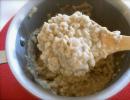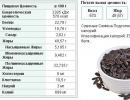Cloudberry - Benefits of Northern Orange
The tundra berry with the gentle name "cloudberry" remains a mystery to many residents of our country - and some have never heard of it at all. But in the North, for several centuries, amber cloudberries have been held in high esteem - its beneficial properties and contraindications were known back in Tsarist Russia, and today preparations from it and the berry itself are one of the main tourist brands of the Scandinavian countries. So what is the unusual arctic berry famous for?
Fragrant Gold of the North
Moss currant, northern orange, swamp amber, arctic raspberry - all this is it, a modest cloudberry. The inhabitant of the coldest regions is a close relative of the popular and, therefore, outwardly these berries are very similar.
For those who want to know what a cloudberry berry looks like, the photo will show small drupes of different shades: from pale orange and red to dark brown and amber. Many researchers call cloudberries “opposite berries” because they ripen so unusually. "Green" fruits have a bright red color, then turn pale and finally acquire a warm orange hue, similar to translucent amber. The berry also grows quite atypically - a dense carpet of a small, up to 30 cm, shrub with bright berries at the top.
You can meet cloudberries in the most difficult places - in peat bogs, in wetlands, and also in the tundra. Arctic raspberries are mined in late July-August, when all the traditional "summer" berries depart, and by the end of autumn, healing roots are harvested. Moss currant is very productive: from one swampy hectare you can collect up to 1000 kg of useful fragrant raw materials.
Despite its "cold" specialization, cloudberries are found in many regions of Russia and the world. Where does this berry grow? Most of the arctic raspberries are in the Tomsk and Arkhangelsk regions, the Komi Republic and the Krasnoyarsk Territory, as well as in the Murmansk and Tyumen regions. Swamp amber is also collected in the Pskov, Novgorod, and Leningrad regions. Cloudberries grow abroad - Belarus, Finland and Canada are considered leaders in the collection and processing of arctic raspberries. So, in Finland, the image of a northern berry has been minted on 2 euro coins for 15 years, and every tourist who loves to drink, unfortunately, takes fragrant cloudberry liquor from Scandinavia.
Cloudberries - a storehouse of essential vitamins
Like many wild berries, a resident of the tundra boasts a solid set of vitamins: A, E, groups B and C, valuable elements: potassium, iron, copper, various acids and sugars. But the main value of the product is in the ratio of these substances. So, vitamin C in 100 grams of cloudberries is four times more than in an average orange, and three times more than in.
In northern countries, amber berries have long been used as a remedy for scurvy and a powerful remedy for. In the cold season, cloudberries are especially valued - their beneficial properties will help with colds, sore throats and more delicate problems. Arctic raspberry has a powerful anti-inflammatory effect: relieves fever during colds, treats diseases of the throat and inflammation of the genitourinary system, especially cystitis.
Fresh and processed, cloudberries are a great multivitamin cocktail for the winter: they will saturate the body with essential substances and help with recovery from both the common flu and more serious illnesses.
Arctic berry in folk medicine
Delicious and healing cloudberries are not accidentally recognized as a real treasure of the northern peoples - recipes from arctic raspberries are still actively used in folk medicine.
Solar berries have a powerful hemostatic effect, as well as diuretic and diaphoretic, which is especially important for colds. A decoction of the fruits of ripe cloudberries is recommended for indigestion, and as an adjuvant for hypertension and vascular problems - the spectrum of action of the northern medicine is so wide.
But cloudberries are famous not only for fragrant berries - Wikipedia describes the various medicinal properties of the leaves and roots of the northern miracle berry. An infusion of cloudberry leaves treats severe diarrhea, metabolic disorders, cystitis and gout, a decoction of arctic raspberry roots will help with malaria, kidney disease, and protracted colds.
When applied externally, swamp amber is also capable of working real miracles: the juice from ripe berries heals traces of tick bites and scabies, and the leaves perfectly draw pus from severe wounds and accelerate healing.
Cloudberry - are there any contraindications?
Despite all the wonderful properties of the berries of the north, cloudberries have a number of contraindications.
The main rule - before use, be sure to make sure that you are not allergic to arctic raspberries. You should not get involved in cloudberries with gastric ulcers and diseases of the duodenum, and with enterocolitis, amber berries are strictly prohibited.
Cloudberry in cosmetology
The unique chemical composition and various vitamins have long made bright cloudberries an active fighter for female beauty. In cosmetology, not only berry juice is used, but also cloudberry seed oil - today leading cosmetic companies produce separate lines based on the northern miracle berry.
Thanks to vitamins E and C, cloudberry products help to soothe irritated and dry skin, perfectly nourish, and remove tightness. The fatty acids in the composition of the arctic berry help to restore the protective barrier of the skin of the face, smooth out early wrinkles, restore firmness and elasticity to the skin of the hands, and hair - radiance and fresh color.

Secrets of use
In pre-revolutionary Russia, all kinds of dishes with cloudberries were regularly served at the royal table, and cloudberry kvass and tinctures were always found in taverns and taverns. Now many recipes are forgotten, but in vain - after all, fragrant cloudberries are equally tasty and fresh, and soaked, and dried. And how much can you cook from cloudberries! Jams, preserves, marshmallows, bright compotes, pies and cheesecakes…
Fresh cloudberries are stored for a short time - only two or three days, after which they begin to ferment. Therefore, in the very first days, the berries must be selected and processed. One of the simplest and oldest northern recipes is soaked cloudberries.
To prepare soaked cloudberries, you need a wooden tub and ripe, but not overripe, berries. We prepare the syrup in advance - about one glass of sugar per liter of water, if you like a sweet berry, or half a glass, if you want more sour cloudberries. Boil sugar syrup, then cool.
The container must be poured over with boiling water and carefully pour orange fruits into it. Fill the cloudberries with water, cover with a clean piece of cloth, on top - a wooden lid with a load. We clean it in the cellar or underground, after 3-4 months the cloudberry is ready.
Such a berry can be used for compotes and jelly, prepare fillings for pies or add to homemade yoghurts.





